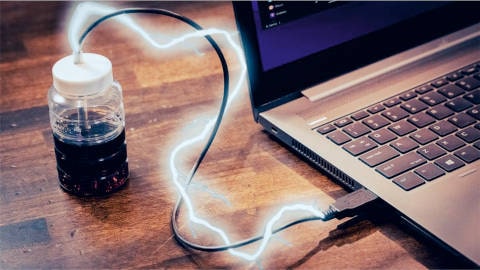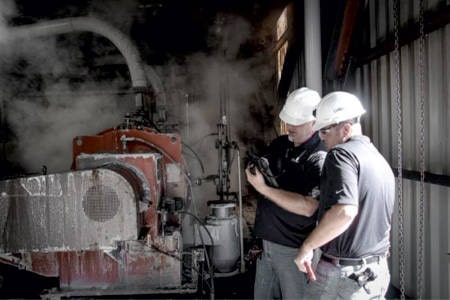Why Lubrication Should Be Outside the CMMS
Those tasked with managing industrial facilities are data-centric, and they desire to track and improve virtually every aspect of the plant. Think about your plant or the last plant you walked through; you likely saw scoreboards or dashboards showcasing key information related to safety, production, maintenance, environmental or other programs that are managed to ensure proper functionality of the machinery and staff.
For improvement to be possible, we must be able to measure; to measure, we must be able to observe. This is where many fall short in their lubrication program — there is no way to observe the program, so it can’t be measured or improved. A great need exists in the industry for a method to manage the chaos associated with lubrication.
Let’s begin by defining lubrication as a fundamental activity for equipment reliability. Regardless of the methodology of asset management you subscribe to, lubrication is one of the key elements required to achieve high levels of equipment reliability. This means lubrication is more than simply a task — it is a collection of activities that must be correctly performed in order to achieve the desired result.
 The definition of a program is “a set of related measures or activities with a particular long-term aim.” This means lubrication is a program and not simply a process or a task; by definition, it is related to a long-term goal. This begs the question: Does anyone treat lubrication as a factor in their facility’s long-term goals?
The definition of a program is “a set of related measures or activities with a particular long-term aim.” This means lubrication is a program and not simply a process or a task; by definition, it is related to a long-term goal. This begs the question: Does anyone treat lubrication as a factor in their facility’s long-term goals?
Most would likely respond that there are long-term goals associated with production, maintenance or safety and would quickly say that lubrication would be wrapped up inside of these. While lubrication is certainly involved with these aspects (as well as many more), it becomes difficult to truly measure the effectiveness of our lubrication program when it is buried inside other data sets. This is why lubrication needs to be managed and controlled separately from other programs within the facility.
A Lubrication Management System
Perhaps the most common place where lubrication is considered to be managed is within the computerized maintenance management system (CMMS). These systems provide insight into maintenance activities, help schedule work and often serve as the main metric gathering place to showcase improvements in maintenance. Since lubrication is often performed by maintenance technicians, it typically gets crammed into the CMMS, with little thought as to whether this is actually the best place for it or not.
 There are many reasons why lubrication should exist outside of a CMMS system and reside in its own system — a Lubrication Management System (LMS). A proper LMS will be able to provide all the necessary information required to understand what is happening in a lubrication program, as well as aid in the ability to track and assign work and plan for future events. The time to employ an LMS in each facility is now, and the benefits of doing so will compound for decades to come.
There are many reasons why lubrication should exist outside of a CMMS system and reside in its own system — a Lubrication Management System (LMS). A proper LMS will be able to provide all the necessary information required to understand what is happening in a lubrication program, as well as aid in the ability to track and assign work and plan for future events. The time to employ an LMS in each facility is now, and the benefits of doing so will compound for decades to come.
Reasons Lubrication Should Exist Outside the CMMS
Lubrication work is different from maintenance and production work and virtually different from work that exists within the different systems utilized inside facilities to track them. While the CMMS is a powerful tool, there are several reasons that lubrication should exist outside the CMMS:
 The number of tasks that are generated in a lubrication program
The number of tasks that are generated in a lubrication program
Lubrication has tasks that are to be completed daily (and sometimes even multiple times a day). A CMMS specializes in PMs that are due routinely but typically not at this level of periodicity. This results in far too many tasks, leading in turn to missed work from the CMMS. A related issue to the number of work orders or tasks that would be generated is the skewing of the dataset, which is often a critical metric in maintenance work order completion.
Imagine this scenario: You are a lube tech working in a facility, and the time has come for you to do your lubrication work in a specific area of the plant. This area includes dozens of small machines that must be greased; this is in addition to a few dozen machines that you weren’t able to complete lubricating yesterday. The CMMS kicks out well over a couple of hundred work orders related to the lubrication activities. A manager logs in and sees a mountain of open work orders as well as a backlog of other work orders that are now overdue. The compliance metric is now in the red, and the decision has been made to close all open work orders to give us a chance to reset and start fresh. In that process, a critical PM was accidentally closed, and two weeks later, a catastrophic machine failure stopped production for 48 hours.
While the scenario above may sound far-fetched, these events happen at plants across the world every day. Extracting lubrication work into its own LMS allows the CMMS to focus on maintenance activities and provides visibility into the lubrication work. It simultaneously gives you the ability to improve both programs.
A lack of critical lubrication information
 The critical information needed to accurately lubricate a piece of equipment is seldom found attached to the equipment in CMMS. This information could include the volume of lubricant, the type of lubricant, the proper procedure to lubricate the component and other pertinent data. Many work orders contain a simple statement like, “clean, inspect and lubricate the machine.” And while being succinct is important, these instructions lead to inconsistent lubrication activities being performed.
The critical information needed to accurately lubricate a piece of equipment is seldom found attached to the equipment in CMMS. This information could include the volume of lubricant, the type of lubricant, the proper procedure to lubricate the component and other pertinent data. Many work orders contain a simple statement like, “clean, inspect and lubricate the machine.” And while being succinct is important, these instructions lead to inconsistent lubrication activities being performed.
A goal of any LMS would be to ensure that lubrication is performed as consistently as possible. To achieve this, you must have solid data for all aspects of lubricating the machine. This would include detailed instructions, pictures and all the information regarding the tools and consumables needed. This level of detail is seldom found in the CMMS and requires significant focus in order to collect and document. The LMS serves as a living receptacle for this information.
Hierarchy constraints
The hierarchy of CMMS constrains where lubrication tasks should be assigned. For many, the PM exists at the machine level, but realistically, the lubrication work occurs at the component/maintenance point level. A single machine could have hundreds of lube points, toward which the CMMS provides no specificity. The LMS treats the point individually, so you get a more microscopic view of the equipment to understand all the discrete tasks that must be performed.
Depending on what CMMS you utilize, you will be forced into a certain level of hierarchy which, in turn, determines how deep you can drill down into your data. While this may be fine in the maintenance world of determining the mean time between failures (MTBF) of a component or machine, it doesn’t allow you to understand how many tasks are being performed, and you completely miss the detailed information that comes from looking at a machine from the aspect of an individual lube point.
Take the example of an electric motor: At the CMMS level, you might see it as a single component. If you have solid data, you will be aware of any differences in bearings between the drive end and the non-drive end. That, however, is where the level of detail stops. This same example in an LMS would be able to provide the individual lubricant volume for each point as well as an individual inspection result from each point. This allows managers to quickly determine if a problem exists on one side of the motor instead of trying to interpret a generic “the motor is getting hot” message.
Lubrication-centric metrics
Lubrication is a program, much like maintenance is a program. Most CMMSs allow for the tracking of metrics related to maintenance but are not specific enough to provide metrics for lubrication. This is a Deming problem: If we can’t observe it, we can’t improve it. The CMMS is the data pool for most of the key maintenance KPIs and is reviewed constantly. With many of the issues listed above, you can understand that since lubrication can’t be tracked effectively in a CMMS, there exists a lack of data to drive the lubrication program.
The lubrication program needs to have its long-term goal and key metrics identified and tracked. With the use of an LMS, you would be able to track each lubrication task individually, as well as a roll-up. Some key metrics like route compliance, contamination control compliance and lubricant consumption ratio become much easier to pull and analyze. Having this data readily available also gives you the ability to provide some predictive analytics to forecast lubricant needs in a timely manner. With the supply chain issues of late, being able to order well in advance helps minimize any emergency situations which may arise from not having the correct lubricant on hand.
 Schrödinger’s cat for lubrication
Schrödinger’s cat for lubrication
Lubricated programs may fall victim to the sociopsychological phenomenon known as Diffusion of Responsibility. This concept posits that an individual is less likely to take responsibility for an action (or inaction) when they are part of a group — instead of taking action, the individual assumes another member of the group has already done so or will do so in the future. For example, take a bearing on a conveyor. This bearing gets walked by every day by several operators, mechanics and supervisors. At this plant, lubrication is considered a “shared responsibility” between maintenance and operations. Each person that walks by this bearing notices that it is making some noise but figures someone else will be by with a grease gun in hand. So, this bearing runs until it fails due to a lack of lubrication. It would very easily happen the opposite way as well. For example, everyone walking by with a grease gun gives the bearing a shot of fresh grease and, in no time, the grease has blown the seal, and the bearing is on borrowed time until contamination and leakage cause a failure.
Without a mechanism to have accountability for tasking and ensuring that the task gets done, our equipment might be either over or under-lubricated. Much like Schrödinger’s cat, the equipment is unobserved and, for all we know, could be in either state. Since the CMMS doesn’t typically track to this level of accuracy (or when operations perform lubrication, they might not be using a CMMS), we don’t have the ability to understand what is happening and by whom. Therefore, an LMS should be employed to shine a light on these scenarios.
Asset Management Best Practices
The term Lubrication Management System exists in ICML’s global standard ICML 55. This standard was written by dozens of experts in the fields of lubrication, maintenance and reliability scattered across the planet. Industry as a whole is focusing on key initiatives like reliability and sustainability. In order to achieve these initiatives, people are looking at standards such as ISO 55000 and, specifically for lubrication, ICML 55. These are key standards for asset management to focus on reliability, thus ensuring the sustainable operation of a plant. Asset management may involve the physical assets such as equipment, human resource assets such as people, and knowledge assets such as documentation and trainings. All of these must be analyzed, and a management plan must be put in place.
Workforce turnover is a very large problem, and it doesn’t just affect us here in the US because of retirement or attrition — it is a key item in the global industry as well. Industrial employers are looking for creative ways to attract, train and retain the best talent they can. In lubrication, an LMS can be a tool that allows employers to market themselves as leaders in the industry.
Put yourself in the shoes of someone interviewing for an industrial job, whether it be in lubrication, maintenance, operations or any other front-line position. In the back of your head, you’re probably thinking about an industrial facility being noisy, hot, dirty, etc., and you likely conjure up thoughts of these jobs being mindless or pointless. During the interview process, you are shown a handheld device (not unlike the phone that you are accustomed to) that details your work and tells you everything you need to know regarding how to properly lubricate and inspect a physical asset. Furthermore, you can see how everything you put in that device adds to the reliability of the equipment you are tasked with maintaining. Your boss will be able to see all the effort you are putting in and reward you for that.
Being able to showcase that the work you are doing is meaningful and impactful is one of the key factors of job satisfaction and engagement. This is hard to do in lubrication without an LMS and often leads to people feeling like they are in a dead-end job and their effort isn’t appreciated. For nearly three decades, it has been Noria’s mission to address just that. We believe that lubrication is a catalyst to remarkable machinery reliability, and to do lubrication correctly, we have to empower the people that are performing these tasks daily.
There is no time like the present to get intentional with what you are doing in lubrication and reliability, and there are tools in the market to help achieve lubrication excellence. We need to stop relying on rigid CMMS structures that can’t treat lubrication properly and look at an LMS that can provide the necessary information to elevate lubrication as a program, as a profession and as a pillar for world-class reliability.
